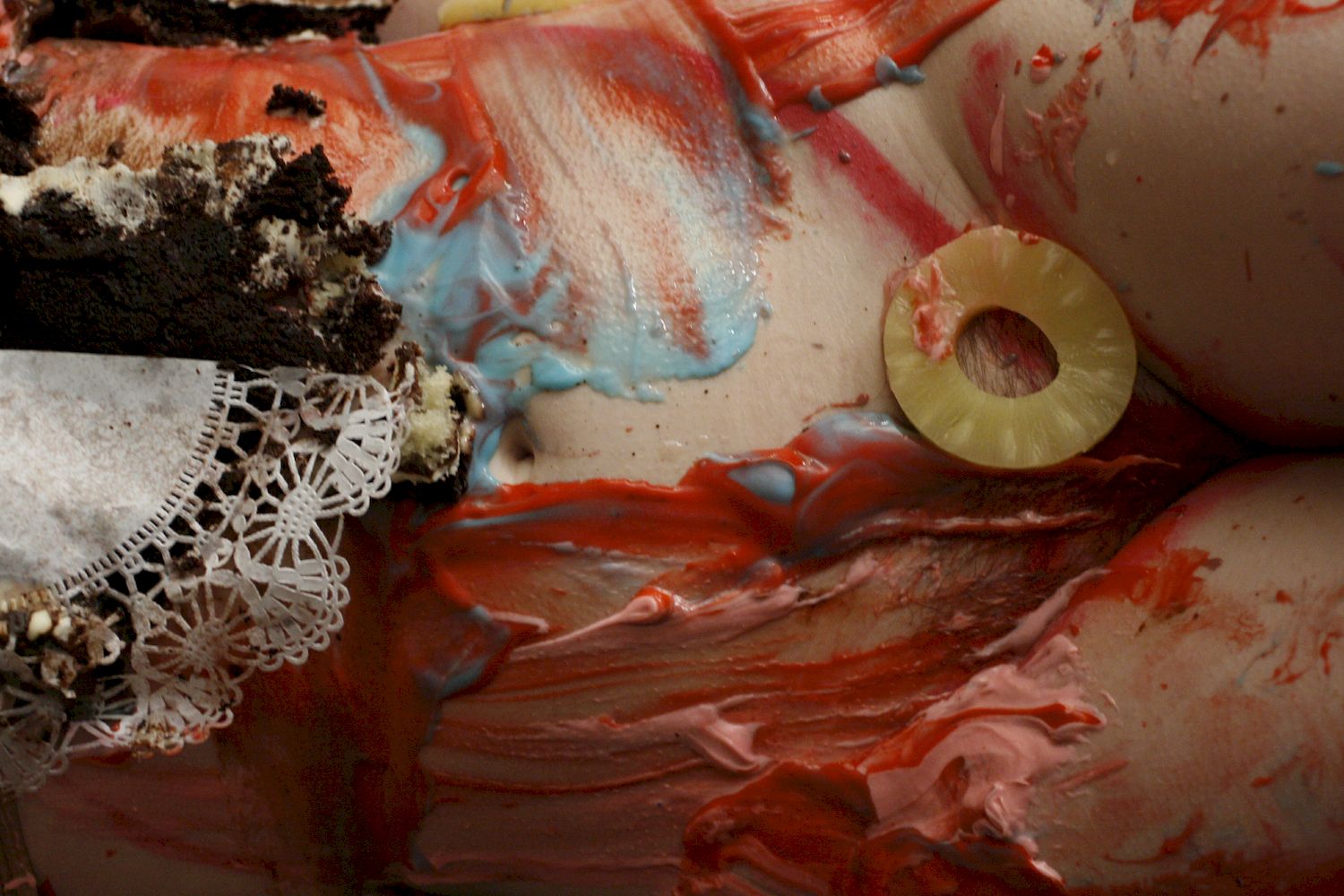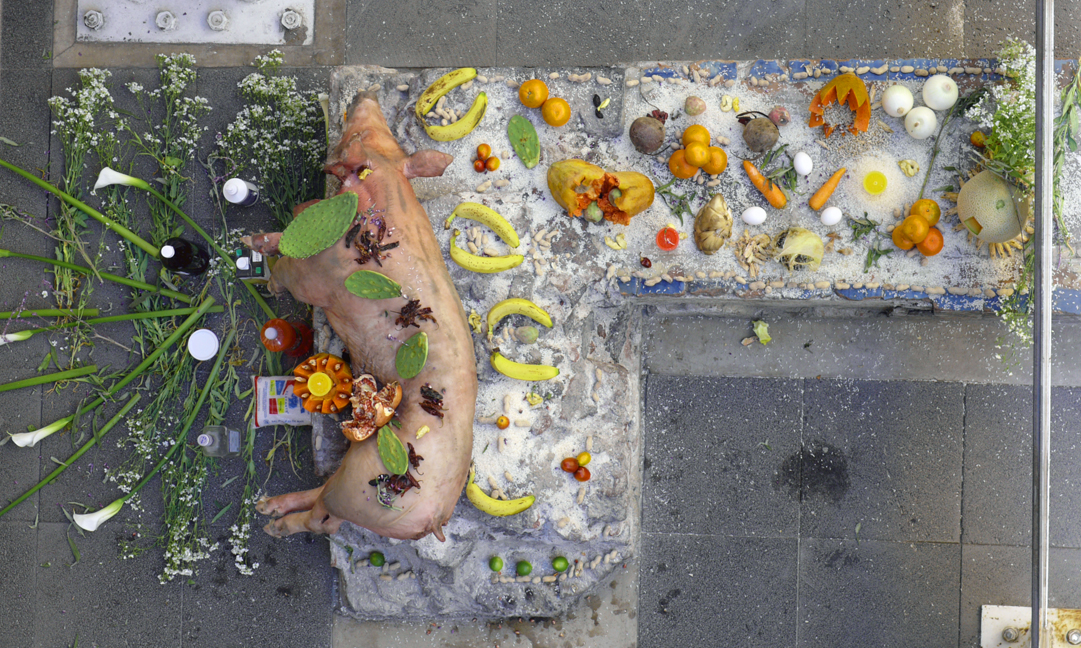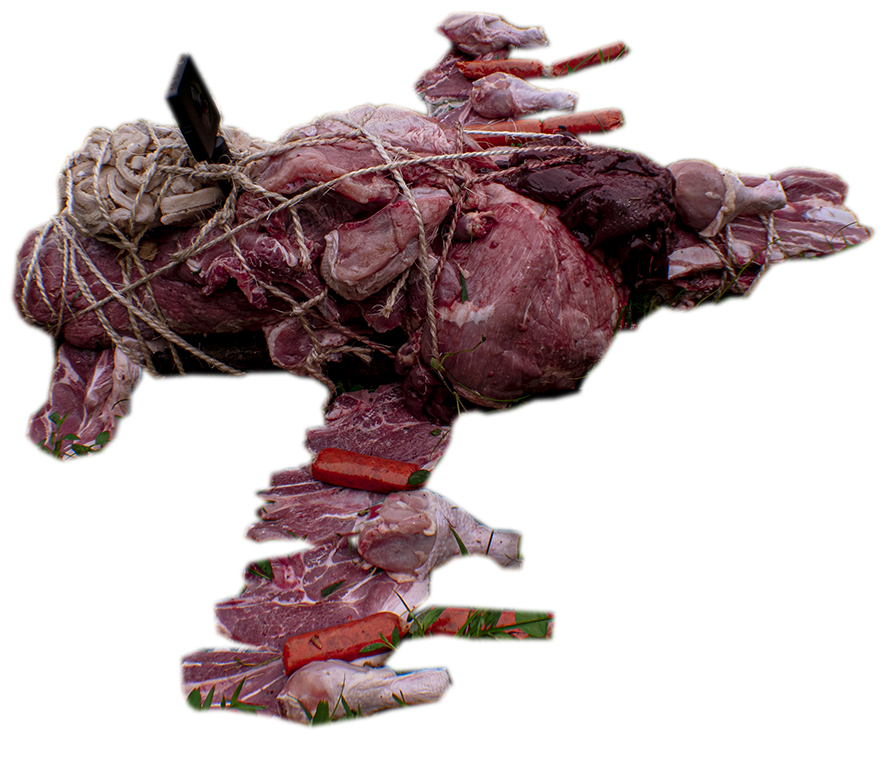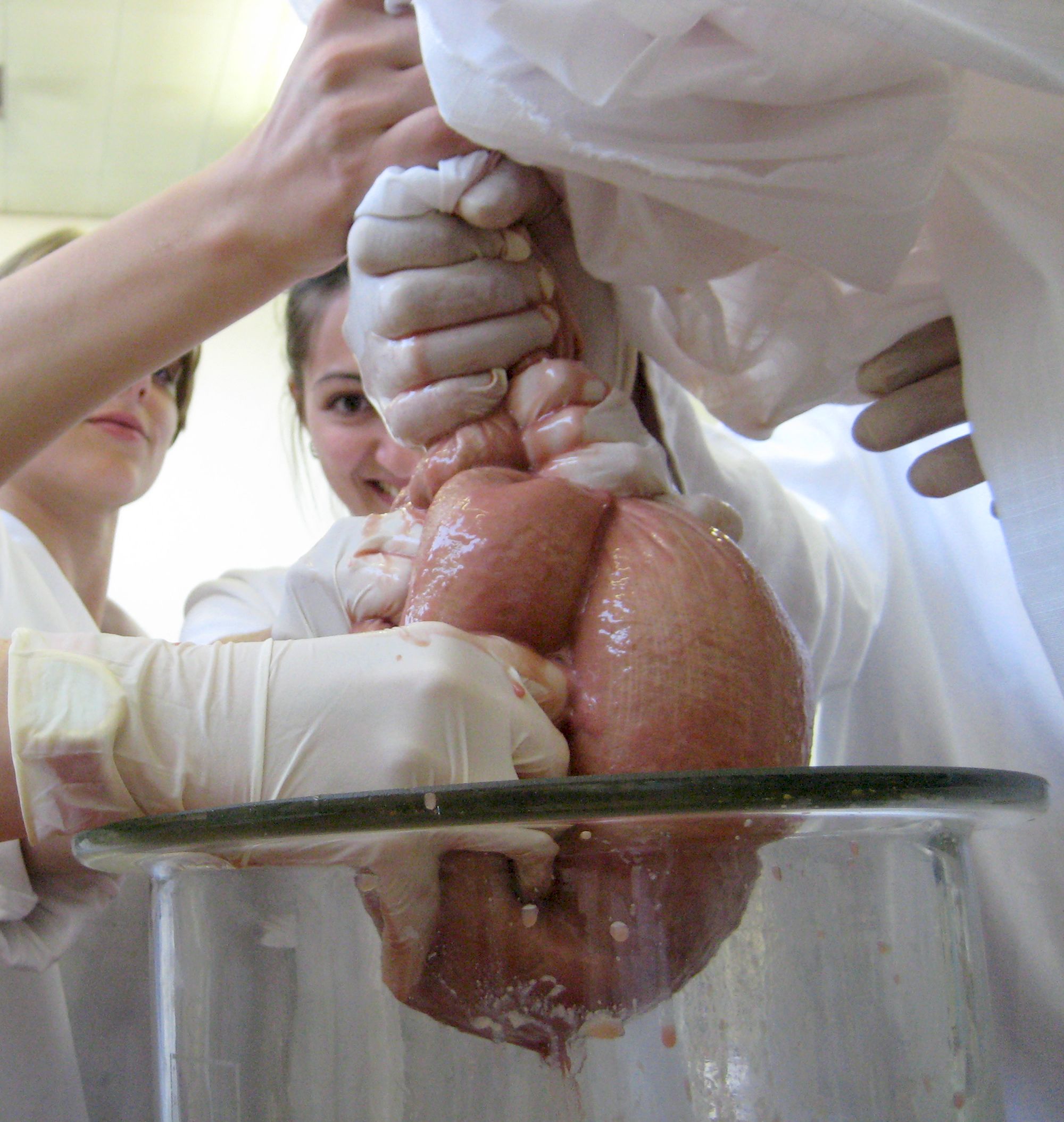Assassin’s Code: Radical Food Science, the Gastronomic Arts and Humane Slaughter
Published 6 August 2021 by Adam Zaretsky
Adam Zaretsky is an American Wet-Lab Art Practitioner mixing Ecology, Biotechnology, Non-human Relations, Body Performance and Gastronomy. Third essay of his summer series of speculative texts based on his own artistic practice and the ethical and philosophical questions he raises regarding contemporary biotechnological research.
How do we read food politics, aesthetics and ethics into the art and science of gastronomic diversity? Issues of famine, starvation and malnutrition mix with over-saturated images from 1950s cookbooks, hot dog eating competitions and new, cholesterol reducing, heart attack allaying drugs. Processed food, genetically modified semi-edible organisms and other monocultures vie for market share. Meanwhile some find solace in eating “healthy”: purchasing from small, local, organic farms or entertaining vegetarian, vegan and macrobiotic diets. Food acquisition, production, preparation and appreciation (including excretion) have had an entertainment value from time immemorial. This is because the diversity of foods, the plethora of political issues, the variety of raw and cooked edible outlets, the methods of preparation of art for your mouth, the ways of eating, and the physiological, aesthetic and ethical reactions to all of the above are so broad and diverse. The following sections will go over some examples of the range of entertaining food politics — from comic to tragic or just bemused.

Home on the Wide Range
The art of food and the effect of food science on what we eat and how we perceive what we eat is an enormous topic.
The eating process is ornate:
1. nose smelling and mouth masticating
2. the aromas and tastes arching down the pathways to our sinuses, tongue and
brain
3. the stomach pleased with mixtures and techniques
4. even supposed pathways to a resistant person’s heart or lower world
One should look at how close to art all of food culture is already:
1. the abstract expressionism of bouillabaisse or ratatouille
2. the filling simplicity of a plate of rice and beans
3. the pop art in every Oreo
4. that “Sotheby’s Feeling” in every bite of Kobe beef
Therefore, issues to explore in the food arts and sciences include but are not limited to:
1. hunger
2. color
3. exotic and taboo delicacies
4. fad diets
5. parasites
6. fragrance
7. genetically modified foods
8. all you can eat buffets
9. factory farming
10. stock breeding
11. certified humane raised and handled carcasses
12. nutrition
13. fermentation
14. recipes
15. access and distribution of food (e.g., famine)
16. molecular gastronomy
17. ethnic foods and racial caricatures
18. slow food
Issues to explore in the food arts and sciences include:
1. hygiene and food safety
2. presentation value
3. the inedible
4. processed food including military Meals Ready to Eat (MREs)
5. varieties of cooking technique
6. inebriants
7. animal rights
8. conservation cuisine
9. oral consumption fixation
10. spice
11. vegan, macrobiotic and raw food regimes
12. banquet architecture
13. eating living animals
14. anorexia, bulimia, gainers/obesity, cannibalism and other eating disorders
15. scatology (including ATM or ass-to-mouth porn subgenres)
16. liposuction
Humane Eating
In a return to the issues of eating with good conscience, Colleen Patrick-Boudreaux in her article “From Cradle to Grave: The Facts Behind Humane Eating,” speaks on the trend in care based animal byproduct labeling. Her article is based on a compilation of meat and dairy compassionate labeling strategies. Patrick-Boudreaux bemoans the trend towards green-washing the facts of slaughter through humane labeling of food-beings with bylines like: free-range, grain-fed, cage-free, antibiotic-free, certified organic, hormone-free and certified humane raised and handled, and soon, genetically heirloom meat.
She pans the self-congratulatory perception of the purchasers of these bagged slices of depersonalized muscle “as ethical consumers and these products as the final frontier in the fight against animal cruelty.” Patrick-Goudreau advocates becoming vegetarian in order to stop the festival of killing as opposed to the wan etiquette of niceties in a slayer’s ritual. “Instead, we absolve ourselves by making what we think are guilt-free choices, failing to recognize the paradox of ‘humane slaughter’. In sympathetic compassion she claims that meat eating is a kind of thrill-kill joy which only ends when we stop eating animals. Advocating for vegetarianism, and therefore revealing her prejudice against biocentric inclusiveness of vegetable isness, she states:
“How can this possibly be considered anything but a rational and merciful response to a violent and vacuous ritual? Every animal born into this world for his or her flesh, eggs or milk – only to be killed for human pleasure – has the same desire for maternal comfort and protection, and the same impulse to live as any living creature.”
Feast and Free Speech
Tangentially, as opposed to dichotomously, Mikhail Baktin famously links banquet imagery to the grotesque body in his book Rabelais and His World. A small taste of Baktin’s focus on the medieval food banquets of Master Gaster and the Gastrolators (from the fourth book of Gargantua and Pantagruel by François Rabelais) revel in, “the carnivalesque war of sausages . . . the longest list of foods in all of literature . . .” and, of course, the usual Rabelaisian food smut involved in farting, swallowing, and even “the open womb of Pantagruel’s mother in the throes of childbirth, from which issued a caravan of wagons loaded with salted food.”
But Bahktin also reads the banquet as “popular-festive tradition, “which differ sharply from the images of private eating or private gluttony and drunkenness in early bourgeois literature.” Linking free speech and future utopias to raunchy, public, working-class festivals of Bacchanalia, the festive eating and drinking is fabulous in its disorganized and proud honesty of conversation. “They express the people as a whole because they are based on the inexhaustible, ever-growing abundance of the material principle. They are universal and organically combined with the concept of the free and sober truth, ignoring fear and piousness and therefore linked with wise speech.”

Edible Perfection: The Reforming of Murder
There are, of course, pure beauty advocates who don’t think much of conservation cuisine. Refusal to think of anything but the ideal can be found in small but meticulous kitchens all over the world, whether they are making the perfect deviled egg or the most well formed tamale. Consider the sensual description of a Japanese Bento Box:
“Within the lunchbox, several dozen parts – each lovely in itself – are arranged in a beautiful manner. The relationship of these parts consists in a delicate, nearly invisible sensitivity that encompasses a ‘living’ installation. This precision in terms of organization is the same quality employed to the full in our creation of industrial products. The more internalized that simple etiquette of assembly for making a lunchbox meal, the more attractive such products become.”
That omnivorous Japanese food display seems to have influenced the design of cameras, cell phones and other entertaining eye and ear feeding devices, in no way attenuates opposing views on beauty’s purity when it comes to display. In critical response to the benign design of red-blooded life as an edible installation, Carol J. Adams speaks of the absent referent in hamburgers,
“What is on the plate in front of us is not devoid of specificity; it is the dead flesh of what was once a living, feeling being. The crucial point here is we make someone who is a unique being into something that is the appropriate referent of a mass term.”
Cooking is always an annihilation of another’s identity. Preparation involves identity remodeling techniques, for instance grinding, boiling, slicing, etc. The animals and vegetables are rendered into their designated, recipe-dependent forms and this is both a way towards beauty and an act of canceling.
Eat Local Rats, Save Energy
“In Columbus’s time, when a ship’s food store ran low during oceanic crossing, the ship’s rat catcher became a man whose low station was elevated, and whose pay was raised when rodents – usually thought to be pests – became a valued protein source.”
Speaking more directly of the value of different protein sources in terms of fossil fuel expenditure reduction,
“Animal rights aside, vegetarians can lose the edge in the energy argument by eating processed food, with its ten calories of fossil energy for every calorie of food energy produced. The question, then, is: Does eating processed food such as soy burger or soy milk cancel the energy benefits of vegetarianism, which is to say, can I eat my lamb chops in peace? Maybe. If I’ve done my due diligence, I will have found out that the particular lamb I am eating was both local and grass fed, two factors that greatly reduce the embedded energy in a meal.”
Humane Slaughter, an Oxymoron?
It is possible that we do not live in a rational and humane world. This is another option for reducing the double bind in the oxymoronic humane slaughter paradox. What if we openly allow the actions of large and small societies to be murderous. Assuredly, there is a variable level of thrill killing and inhumane slaughter which each culture, subculture, cult or global mass movement keeps up to preserve the sacrificial economy of cohesion. Referring to the family resemblance, openness and gooey poetry that “the animal” inspires in us, George Bataille follows with an admission, or one might say, a lapsed confession: “But this too is poetry…. Insofar as I can also see the animal as a thing (if I eat it – in my own way, which is not that of another animal, — or if I enslave it or treat it as an object of science)…”
Is this the standard unspoken mirror to which a feeling for industrial-organismic holism leaves us coddled and cozy in the culture of gore, the body horror of culture, the slick and yet messy, visceral realm of the edible?
The VASTAL Food Science and Gastronomic Arts: Hybrid DNA Isolation Lab was held in the Farmer’s Market of Nieuwmarkt, May, 30, 2009. Video direction, Camera and Edit: Jeanette Groenendaal and Zoot Derks.
Assassin’s Code
A novel starting point when analyzing bioethics in the realm of humane sacrifice, human and non-human subjects in scientific or humanities research, food/death studies and the hereditary reengineering of the preconceived, is to take a look at the “Attributes of the Professional Assassin.” Imperial war makes soldiers of us all, but what kind of person makes a fine killer (or even the “finest killer”)? With this information we may be able to feel why performing the process of butchery, surgery, animal research and other forms of sacrificial execution is not everyone’s cup of tea. Being a killer is not a psychologically unskilled job. You may be surprised to hear that according to Bradley J. Steiner, author of The Death Dealer’s Manual, reliable government assassins (aka terminators) are rare.
“If the number of intrinsic killers is small, then the number of reliable, stable-minded, and intelligent people who can be trained to kill on assignment, again and again, and have no remorse or other inner conflicts as a result, can be said to be miniscule.”
So, the psychological attributes of the targeted slayer of life do not include criminals or deranged persons as they are generally unprofessional and have motives beyond fruitful productivity. Save the antisocial, punk, misfit regalia for the movies. To be an efficient predator calls for tepid and methodical asocial imperatives (which are not to be confused with antisociality). Along with well-directed and skilled ferocity, Steiner suggests a particular form of coldness.
The professional killer needs to be genuinely and inwardly cold in the profoundest, deepest sense. … his deepest philosophy regarding others is chilling. The professional thinks of all other people as being unimportant metaphysically. They are hardly ‘people’. They do not retain any of the ‘rights to live’ that so many ordinary individuals are fond of speaking about.
But the harsh psychological assessment of the rational, neurasthenic assassin is also the value system most required of animal researchers. Humane Sacrifice in sacrificial science values the humanity of the good death. This is expressed through cool, prompt and efficient ends. “Euthanasia should be carried out in a manner that avoids animal distress. In some cases, vocalization and release of pheromones occur during induction of unconsciousness. For that reason, other animals should not be present when euthanasia is performed.” (Institute for Laboratory Animal Research (ILAR), Guide for the Care and Use of Laboratory Animals, Commission on Life Sciences, National Research Council, ed. Norman Grossblatt (Washington, D.C.: National Academy Press, 1996), 66.)
In comparison, the training of proficient animal researchers involves a process of discovering who does and who does not have the particular coldness of the professional assassin.
“When delegating euthanasia responsibilities, supervisors should be aware of this as a potential problem for some employees or students.” This supervisory choice is a weeding out process towards training good death dealers through appropriate delegation. A choice of preferred psychological attributes is being made through invitation to actions and analysis of responses to these acts. Implicit in the relationship is a reward for coolness in sacrifice, “to ensure that the end point is humane and the objective of the protocol is achieved” through a variety of techniques including “inhalant or noninhalant chemical agents (such as barbituates, nonexplosive inhalant anesthetics, and CO2)” and “physical methods (such as cervical dislocation, decapitation, and use of a penetrating captive bolt).” Which leads us to wonder, what is the essence of the form of humanity implied by the oxymoron of humane sacrifice? How is the method of sacrifice made more humane through detached, efficient following of termination protocols?
What About Putting the Sacred Back into Sacrifice?
The sheer honesty of an assassin’s behavioral checklist is appreciable. What seems to be lacking in this model of the supramoral is the intimacy of sacred sacrifice in the rational project of humane slaughter. Even depersonalized, objective and removed ways of being are practicing a sort of empirical sacral philosophy, but it is not without a certain lack. In the current Institutional Animal Care and Use Committee (IACUC) climate, “(i)t is essential that euthanasia be performed by personnel who are skilled in methods for the species in question and that it be performed in a professional and compassionate manner”. The price we pay for skill is a rendition of slaughter reduced to compassionate professionalism. George Bataille in his Theory of Religion, advocates a return from these real world, inured genocides, advocating intimate sacrifice.
“This real-world having reached the apex of its development can be destroyed, in the sense that it can be reduced to intimacy. … It will regain intimacy only in darkness. In doing so it will have reached the highest degree of distinct clarity, but it will so fully realized the possibility of man, or of being, that it will rediscover the night of the animal intimate with the world – into which it will enter.”
The movement is towards an excessive animalistic festival on the future plazas of human sacrifice. To approach a clear consciousness of non-knowledge, of the night, one must regale a yearning for awakening from the order of things. Bataille celebrates the anguish which sacrifice applauds. But, until all animal and human sacrifice is practiced artistically or at least with celebration in the food courts of malls, we should continue with the project of getting to know our others and preserving their wild environments (even in captivity) for our future embarkment fantasies. These theoretical disjunctures are, in the terms of living rights, exhibited in every edible masterpiece, meal, snack, nosh, etc.

Food Funeral
Along with making sacrificial practices more public and bringing back cannibalism, there is the option of practicing funereal rites for the killing that sustains us. Jeffrey Valance’s burial of Blinky, a chicken engineered and packaged for frying, is one of many styles of rites, which could engage the issues of food politics with respect for nonhuman otherness and the evanescent humor of realism.
“One day I went to Ralph’s supermarket in Canoga Park, where I usually shopped at, and bought a regular Foster Farms fryer chicken wrapped in a plastic bag. … Then I called up a pet cemetery and told them I had a dead bird that I wanted to bury, and didn’t tell them any more information about it. I took off the plastic bag and then put Blinky in a shoebox, … I had ordered a powder blue coffin with a pink lining, and they had put a paper towel in the bottom, because Blinky was starting to thaw and beads of sweat were forming on the chicken which would have ruined the satin. There was a little pillow inside, and they had placed it so that if the head were on, it would have been laying on the pillow. But it didn’t have a head, so… [laughs]”
One might hope that Blinky’s headstone exists to this day in Southern California, committed to memory, a form of Californian memory, not timeless memory, but to a time with more longevity than most Foster Farms fryers. Blinky’s memorial stands in for millions of deep fried meals and the beings they used to represent. But, Vallance has one upped Blinky’s memorial. Blinky has been exhumed and reliquaries of Blinky’s remains are presently touring. This is a different kind of intimacy, dark, yes, but not in the way Bataille insists on the leaving of the real world and becoming the behind, the dark star of the animal night.
All of Culture Is Mere Art, but All Art Is Still Craft
The debate over how to judge food art on decorative or aesthetic grounds revives the debate between craft and art or utility versus cultural artifact. The presumption that creativity can be enacted as an art without other uses ignores the use of art as an investment tool. Art becomes craft when it is a portfolio to be leveraged against or retired upon. We even have to consider cultural capital as the “utility” of art as prime decoration for those who need to impress. Individuals, corporations, museums and nation states with original, one-of-a-kind pieces have swag to complete their status brag in a social milieu often (but not always) far removed from an artist’s peer group or original intent. All art is craft and all art is political in this sense (as well as others). Food art challenges the tired debate of craft (design/engineering) being excluded from Art (research/science) by focusing on creative, sometimes-edible expressions tabled around issues of rawness and cookery, the edible and the inedible, new tastes and novel food collage as sculpture, and the ethics of varieties of consumption arrays. But, social actors with their crumbs of agency are engaged on the stage of the alternate eating tableau.

Food Is More Than Fuel
The performative nature of social coming together for consumption is always overlaid with situational specific eating etiquettes. The otherwise personal cognitive responses to the smells and tastes of masticating individuals are affect-added by the art of food culture: the question of food sources, the way of food preparation and the stage of eating. Though digestion is generally relegated to nourishment as a physiological fuel processing metaphor, the feelings of satiation, indigestion, DNA isolation and even excretion result in an aesthetic dimension which can be read without the use-value lens of machinic metaphors.
The Ethics and Aesthetics of Creative Gastronomy
It’s so beautifully arranged on the plate, you know someone’s fingers had been all over it. So as we can see, in the arts, which is to say in the world, designing feasts, recipes and plated plates is a medium of expression tarnished (or polished) by exploitation. For this reason, food art and design automatically includes emotional, political and improvisational actions contra to standard etiquette. There is no meal that is not partially uncovered in its abjection. Food preparation is a busy playtime creating a situation that requires the invention of new rules of disorder. Presenting radical food productions is a way to exhibit the implicit issues of hunger and desire through taboo foods and ephemeral oral compulsions.
The ethics of food arts include asking: What are the sources of the foods in your installation? Do food sources matter? What does it mean to make creative expressions for someone else’s taste, nutrition or digestion? What are the possible interfaces (besides your taste buds, your sense of smell, your gut and your anal responsiveness) where your body might inform, interact, consume, prepare, expel or enrich radical food practices? Who is not getting enough to eat, starving or embroiled in famine? And, how does the global gluttony footprint effectively empty the stomachs of so many? Celebrating abundance with tacit knowledge; all the channels of biopolitical and zoopolitical controversy are delicate matters. Therefore, the aesthetic designing of banquets or any sort of excessive, expensive food installation has its own ethos and bittersweet festive nuance.
References
– Jack Sargeant, “Filth and Sexual Excess: Some Brief Reflections on Popular Scatology,” M/C: A Journal of Media and Culture 9, no. 5 [2006], http://journal.media-culture.org.au/0610/03- sargeant.php
– Kymberlie Adams Matthews, “Decoding the Label: A Brief Guide to Meat and Dairy Labels and their Relevance to Animal Welfare,” Satya: Vegetarianism, Environmentalism, Animal Advocacy, Social Justice (September 2006): 32-34.
– Colleen Patrick-Goudreau, “From Cradle to Grave: The Facts Behind ‘Humane’ Eating,” Satya: Vegetarianism, Environmentalism, Animal Advocacy, Social Justice (September 2006): 34.
– Kenji Ekuan, “Beauty is Function,” The Aesthetics of the Japanese Lunchbox (Boston, MA: MIT Press, 1998).
– Carole J. Adams, The Pornography of Meat (New York: Continuum, 2004), 12.
– Georges Bataille, “Animality,” in Animal Philosophy, Ethics and Identity, ed. Peter Atterton and Matthew Calarco (New York: Continuum, 2004), 35.
– Georges Bataille, Theory of Religion, trans. Robert Hurley (Brooklyn, NY: Zone Books, 1992), 69-104.
– Jerry Hopkins and Michael Freeman, Strange Foods: Bush Meat, Bats, and Butterflies; An Epicurean Adventure Around the World (Hong Kong: Periplus Editions, 1999), 15.
– Richard Manning, “The Oil We Eat: Following the Food Chain Back to Iraq,” Public: Eating Things 30 (2004): 55.
– Bradley J. Steiner, “Attributes of the Professional Assassin,” in The Death Dealer’s Manual (Boulder, CO: Paladin Press, 1982), 93.
– Jeffrey Vallance with Boyd Rice, interview by V. Vale, Re/Search 11 (1987): 110-11.
– Jeffrey Vallance, Relics and Reliquaries (New York: Grand Central Press, 2008).
– Julia Child, Food and Drink: A Book of Quotations, ed. Susan L. Rattiner (Toronto, Canada: Dover, 2002), 18.
– Beatriz Preciado, Contrasexual Manifesto [Berlin, Germany: Kontrasexuelles Manifest, 2004], cited in Tim Stüttgen, “Ten Fragments on a Cartography of Post-Pornographic Politics,” C’lickme: A Netporn Studies Reader, ed. Katrien Jacobs, Marije Janssen, and Mateo Pasquinelli [Amsterdam, Netherlands: Institute for Network Cultures, 2007], 279
Read First – Transgenic Ecology, an Oxymoron? – and Second text – BioSolar Cells, Making a Field for Interpretation – of Adam Zaretsky’ summer series
Recent news: Grace Exhibition Space at Rosekill, NY presents: Linda Mary Montano and Adam Zaretsky, three days of meditation in: EcoArt Life Death-Rehearsal Performance. Montano and Zaretsky lying in the eco-womb rehearsing death through engaged practice: 3 Hours a Day for Three Days, Thursday Friday Saturday, August 12, 13, 14, 3PM – 6PM EST, Eco-Ego Surrender Funeral Procession, Saturday August 14th, 5:00 – 6:30 EST, 2021
